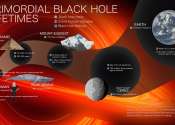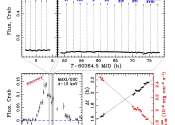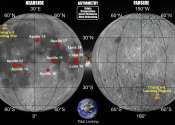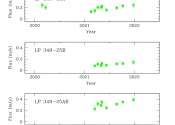Last update:
Astronomy & Space news

How NASA's Roman mission will hunt for primordial black holes
Astronomers have discovered black holes ranging from a few times the sun's mass to tens of billions. Now a group of scientists has predicted that NASA's Nancy Grace Roman Space Telescope could find a class of "featherweight" ...
Astronomy
1 hour ago
0
63

New accreting millisecond X-ray pulsar discovered
Astronomers report the discovery of a new pulsar using the Spektr-RG space observatory. The newfound object, designated SRGA J144459.2−604207 (or SRGA J1444 for short), turns out to be a bursting accreting millisecond X-ray ...

A triumph of galaxies in three new images from the VLT Survey Telescope
Distant galaxies, interacting galaxies, whose shape has been forged by the mutual gravitational influence, but also galaxies forming groups and clusters, kept together by gravity—they are the protagonists of three new images ...
Astronomy
1 hour ago
0
30

Boeing Starliner crewed mission postponed until at least Friday
The first crewed launch of Boeing's Starliner spaceship will have to wait until at least Friday to give ground teams time to analyze a malfunctioning rocket valve, pushing back a high-stakes test trip to the International ...
Space Exploration
1 hour ago
0
0

Geologists reveal mysterious and diverse volcanism in lunar Apollo Basin, Chang'e-6 landing site
The far side of the moon is a mysterious place that is never visible from the Earth. The most remarkable feature of the moon is its asymmetry between the lunar near side and far side in composition, crust thickness, and mare ...
Planetary Sciences
2 hours ago
0
17

Hubble views a galaxy with a voracious black hole
Bright, starry spiral arms surround an active galactic center in this new NASA Hubble Space Telescope image of the galaxy NGC 4951.
Astronomy
1 hour ago
0
17

Billionaire's 2nd SpaceX trip featuring spacewalk aims for early summer launch
Billionaire Jared Issacman, who flew to space once with SpaceX, is already set for launch No. 2 in early summer.
Space Exploration
1 hour ago
0
1

Video: Using a hopping robot for asteroid exploration
One day the SpaceHopper will be deployed on space missions to explore relatively small celestial bodies such as asteroids and moons. These are thought to contain valuable mineral resources that could be of use to humankind ...
Space Exploration
1 hour ago
0
1

What can early Earth teach us about the search for life?
Earth is the only life-supporting planet we know of, so it's tempting to use it as a standard in the search for life elsewhere. But the modern Earth can't serve as a basis for evaluating exoplanets and their potential to ...
Astrobiology
1 hour ago
0
1

Boeing Starliner crewed mission postponed shortly before launch
The first crewed flight of Boeing's Starliner spaceship was dramatically called off just two hours before launch after a new safety issue was identified, officials said Monday, pushing back a high-stakes test mission to the ...
Space Exploration
13 hours ago
0
16

New black hole visualization takes viewers beyond the brink
Ever wonder what happens when you fall into a black hole? Now, thanks to a new, immersive visualization produced on a NASA supercomputer, viewers can plunge into the event horizon, a black hole's point of no return.
Astronomy
23 hours ago
0
525

Boeing's first Starliner mission with humans set for historic Space Coast launch tonight
The stage is set for some space history to be made tonight as two veteran NASA astronauts aim to launch in a spacecraft that has never flown with humans before.
Space Exploration
23 hours ago
0
191

China publishes world's first high-definition lunar geologic atlas
China has released a geologic atlas set of the global moon with a scale of 1:2.5 million, which is the first complete high-definition lunar geologic atlas in the world, providing basic map data for future lunar research and ...
Space Exploration
23 hours ago
0
20

Shining a light on untapped lunar resources
Near the moon's south pole lies a 13-mile wide, 2.5-mile-deep crater known as Shackleton, named for Antarctic explorer Ernest Shackleton. Shackleton—and craters like it—may contain untapped resources that can be accessed ...
Space Exploration
22 hours ago
0
13

Study investigates a nearby M-dwarf binary system
Using the Very Long Baseline Array (VLBA), astronomers have explored a nearby binary stellar system composed of two M dwarfs, known as LP 349−25AB. Results of the study, presented April 25 on the pre-print server arXiv, ...

Radio astronomers bypass disturbing Earth's atmosphere with new calibration technique
An international team of researchers led by astronomers from Leiden University (Netherlands) has produced the first sharp radio maps of the universe at low frequencies. Thanks to a new calibration technique, they bypassed ...
Astronomy
May 6, 2024
2
338

Astronomers observe elusive stellar light surrounding ancient quasars
MIT astronomers have observed the elusive starlight surrounding some of the earliest quasars in the universe. The distant signals, which trace back more than 13 billion years to the universe's infancy, are revealing clues ...
Astronomy
May 6, 2024
1
173

Compared to billions of years ago, Venus has almost no water: New study may reveal why
Planetary scientists at the University of Colorado Boulder have discovered how Venus, Earth's scalding and uninhabitable neighbor, became so dry.
Planetary Sciences
May 6, 2024
0
39

Scientists' research answers big question about our system's largest planet
New discoveries about Jupiter could lead to a better understanding of Earth's own space environment and influence a long-running scientific debate about the solar system's largest planet.
Planetary Sciences
May 6, 2024
0
31

The universe could be filled with ultralight black holes that can't die
Primordial black holes are hypothetical objects formed during the earliest moments of the universe. According to the models, they formed from micro-fluctuations in matter density and spacetime to become sand grain-sized mountain-massed ...
Astronomy
May 6, 2024
0
90
More news

Boeing's Starliner set for first crewed mission to ISS

Boeing's Starliner finally ready for first crewed mission

Boeing's Starliner joins select club of crewed US spaceships

Earth from space: Namibian landforms

What can AI learn about the universe?

Ariane 6 launches: Exolaunch's EXOpod Nova

Making sure ESA's cloud and aerosol satellite is aerosol-free

Intercropping viable for optimizing vegetable production on Mars

Two small NASA satellites will measure soil moisture, volcanic gases
Other news

Chimps shown to learn and improve tool-using skills even as adults

Research team discovers new property of light

Researchers 'unzip' 2D materials with lasers

New super-pure silicon chip opens path to powerful quantum computers

How a 'conductor' makes sense of chaos in early mouse embryos

Dogma-challenging telomere findings may offer new insights for cancer treatments

Decoding development: mRNA's role in embryo formation

Study sheds light on cancer cell 'tug-of-war'

Pulsed plasma rocket (PPR): Shielded, fast transits for humans to Mars

Japanese aerospace company captures an actual picture of space debris

NASA does Dragon shuffle prepping for Starliner launch

NASA balloons head north of Arctic Circle for long-duration flights

Why parrots sometimes adopt—or kill—each other's babies

Rich molecular language guides tiny liquid droplet formation in cells

Microbiome studies help explore treatments for genetic disorders

Fruit fly model identifies key regulators behind organ development

Free-forming organelles help plants adapt to climate change
































